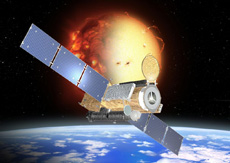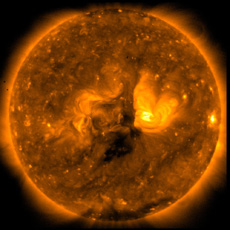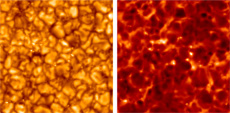

Q. How is HINODE being received outside Japan?
Some media have published high-resolution images taken by HINODE's Solar Optical Telescope, referring to it as the "Hubble for the Sun". Since HINODE's launch more than a year ago, we have received a significant amount of observation data, which already has been the basis of more than 80 papers. Its initial observations have been very well received, with many science magazines featuring the mission. A prominent U.S. Science magazine even used one of HINODE's X-ray images on its cover. When the results of HINODE are presented at international conferences, we always receive praise for its high-resolution and magnetic field observations.

Solar physics satellite HINODE
Q. What is the latest news from HINODE?
HINODE continues to perform its mission as the world's orbital solar observatory. Our observations are made in collaboration with researchers from other solar observation satellites and ground observatories around the world. We are currently watching the “quiet” Sun, now in its phase of least activity in the solar cycle (known as the solar minimum). In early 2008, active regions (sunspot groups) of the next solar activity cycle began to emerge, and we can finally start to observe the Sun gearing up for more vigorous activities. We plan to increase our observations focusing on flares and active regions. While the onboard observation telescopes have been providing excellent research, at the end of last year we began to experience irregularities with the X-band transmitter signal, which is used to transmit observation data. We are in the process of working out how to minimize this effect and how to improve methods of data reception and scientific operations so that we can maintain the quality of our observations. We look forward to sharing new scientific results from HINODE.

The Sun observed by X-ray telescope. The corona appears brighter than the surface of the Sun because X-rays are emitted from hot plasma.
Q. What future observations are you most excited about?
HINODE's greatest asset is its ability to observe the Sun in three dimensions, integrating the optical, ultraviolet and X-ray telescopes. For the research we've conducted so far, a single telescope has been sufficient, so we haven't really had a chance to take advantage of all three telescopes at once. In that sense, HINODE's true observation and research capability is yet to be revealed. By exploring magnetic fields on the Sun as well as coronal heating and activity, we should initially examine the relationship between magnetic field variations and the consequences that occur above them. Observation data captured by multiple instruments will allow us to look into physical phenomena of the Sun from various perspectives. Such comprehensive research has never been carried out before so I am very excited about the compelling results that HINODE makes possible.
Currently, as mentioned, the solar activity cycle is at a relatively low period, and therefore, the observation of explosive events in active regions is very limited. Fortunately, we were able to observe the eruption of the largest flares in the current solar minimum. The first sunspot appeared in early 2008, confirming the onset of the new solar cycle, when the Sun starts becoming active again. At solar maximum, we expect to witness a large flare that will have a greater impact on the Earth's environment and its vicinity than has ever been observed before, so we will definitely keep an eye on the Sun's activity. I'm looking forward to capturing more solar explosions from different angles.
HINODE is a three-year mission, but our project team would like to carry on observation as long as possible, and we are hoping that our mission will be extended. HINODE's predecessor, Yohkoh, was originally scheduled to last for just one year but it continued its observation for a full 10 years. Yohkoh successfully captured images of the solar corona during almost the full length of the solar cycle, leaving us with remarkable data. We continue observation with HINODE hoping to watch the Sun at maximum from 2010 to 2011. I am sure that HINODE will bring us extraordinary results, promising advancement in solar physics and related fields.

Q. What in particular would you like to research with HINODE?
I've been analyzing the observation data of HINODE hoping to understand the dynamic motion of magnetic field lines on the Sun. It is essential to observe the field lines in order to have a good understanding of their behavior, as coronal heating and activity is thought to be caused by their violent motions. With the spectro-polarimetric data obtained using the SOT on HINODE, we are finding frequent gas flows at speeds that exceed sonic velocity, in conjunction with changes in magnetic field lines and magnetic field structures. For instance, we have been observing the evolution of intense magnetic fields on the Sun, and high-speed gas flows that can be detected thanks to stable sunspots. By comprehensively examining gas flows and magnetic fields, observed polarimetrically, I'd like to gain greater understanding of the dynamic behavior of magnetic field lines.
I'm also interested in the physical processes of the microflaring that frequently occurs in the corona (a microflare is smaller than a flare, but bigger than a nanoflare). In Yohkoh's era, microflares were expected to be a key to explaining coronal heating. However, my observational research has found that microflares do not provide a full explanation for coronal heating, although they do play an important role in producing hot coronal plasma. The focus of exploration is therefore shifting to nanoflares. However, it is possible to look at microflares as the simplified prototype of a flare. To understand the elemental processes of coronal activity, it is extremely important to resolve how explosions erupt in the corona in correlation with magnetic field lines on the surface. Microflaring is only seen at certain locations on the Sun. I'm keen to uncover its origin.
Previous research has confirmed that a microflare sometimes occurs when a small magnetic field emerges from below the solar surface, interacting with the existing magnetic field on the surface. However, there is likely to be microflaring that does not require this process, and I think that HINODE's high-resolution observation will be able to identify it. As I have mentioned, HINODE's main feature is its precise, three-dimensional measurement of solar magnetic fields, making it possible to measure the magnetic field vector, which allows for the detection of electric currents. HINODE has found that microflaring does not always require the emergence of a magnetic field on the surface, but that it is also possible in regions that have strong electric currents. I understand this to mean that electromagnetic field lines are somehow interacting with each other in the upper corona, releasing energy. We are observing this process for the first time. Further analysis and speculation is required, but I expect that the results will be very exciting.
Q. What attracts you to solar observation?
The Sun is our closest star. What happens there, such as solar winds and flares, impacts Earth's magnetosphere and our surroundings in many ways, having a significant impact on life on our planet. My attraction to astronomy comes mostly from intellectual curiosity, wanting to seek the origin of life. As for observing the Sun, I want to note the Sun's importance in our daily lives.
The Sun is always there when you look up, and for that reason it has long been the object of human study. As a result, there was a time when it was deemed out of fashion to study it. But the solar observatory Yohkoh changed that climate. It started providing us with brand-new, dynamic images of the Sun in 1991, stimulating astronomers' curiosity.
While the Sun is our closest star, it is also the only celestial body on which we can, through detailed observation, do spatial and temporal analysis of magneto-hydro dynamical phenomena, which also occur in space. The elementary processes of the Sun's variations, activity and heating system are the physical processes that involve magnetic field lines and plasma, and they can be applied to celestial bodies at greater distances from Earth. Still, there is so much to learn about the Sun. Today, the age-old study of the Sun is new again. Understanding our closest neighboring star helps us better understand space beyond. This is also what keeps me interested in solar observation.

(Photos: JAXA, National Astronomical Observatory of Japan)
Doctor of Science. Associate Professor, Department of Basic Space Science, Institute of Space and Astronautical Science, JAXA
Dr. Shimizu graduated in 1995 from the Department of Astronomy, Graduate School of Science, at the University of Tokyo. He was appointed to his current position after working as research associate at the National Astronomical Observatory of Japan. He specializes in solar physics, and has been developing onboard instruments for space vehicles such as HINODE.
X-ray Astronomy Satellite
Suzaku
Infrared Imaging Satellite
AKARI
Solar Physics Satellite
HINODE
Radio-Astoronomical Satellite
ASTRO-G
